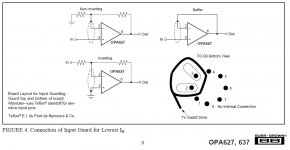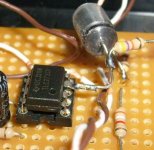That kind of guarding is usually for those that use cheap boards and want high impedance inputs (Teflon boards cost about $1 a square inch last time I checked).
I had to use a guard ring on a low frequency spectrum analyzer integrator cap, otherwise the charge would bleed off too fast.
I had to use a guard ring on a low frequency spectrum analyzer integrator cap, otherwise the charge would bleed off too fast.
Jan, this technique usually has nothing to do with noise reduction as applied to audio. Basically, the idea of the guard is to prevent leakage currents on the PCB from upsetting the DC performance of the op-amp. The guard ring is tied to a low source impedance which is at the same potential as the inputs. This can be accomplished by buffering the feedback voltage divider with a second opamp. The guard ring intercepts any leakage currents arising from delta voltages elswhere on the pcb .
Note that or this echnique to work, a double ided PCB is required (if using more than 2 layers, GR is required on every layer).
Might reduce very low frequency leagage noice in an mc amp, but I only have (good) experience using this technique on thermocouple amps.
Note that or this echnique to work, a double ided PCB is required (if using more than 2 layers, GR is required on every layer).
Might reduce very low frequency leagage noice in an mc amp, but I only have (good) experience using this technique on thermocouple amps.
good point from djk - giard ring is absolute must for integrator applications - usually in dual slope A-D applications
to prevent leakage currents I bend the input-pins and wire them free air.
But thats not audio
regards
But thats not audio
regards
juergenk said:to prevent leakage currents I bend the input-pins and wire them free air.
But thats not audio
regards
called "dead bug" -- popular in low power ham radio applications as well.
Hi ACD,
If you need to go to that extent, air currents can generate much more noise also. One of those things. Thermal drift is also noise, and once again air currents can really mess things up.
-Chris
Edit: Hi juergenk,
Sockets tend to make everything much worse. From capacitance to thermocouple effects. Many more paths for leakage too!
If you need to go to that extent, air currents can generate much more noise also. One of those things. Thermal drift is also noise, and once again air currents can really mess things up.
-Chris
Edit: Hi juergenk,
Sockets tend to make everything much worse. From capacitance to thermocouple effects. Many more paths for leakage too!
Hi Chris,
thats not an audio circuit, the (+)input-pin is bend up to preserve the GOhm input impedance and avoid leakage currents.
The socket doesn't hurt in this special application.
Guess the hints in the BB datasheet weren't meant for audio circuits too.
Regards
thats not an audio circuit, the (+)input-pin is bend up to preserve the GOhm input impedance and avoid leakage currents.
The socket doesn't hurt in this special application.
Guess the hints in the BB datasheet weren't meant for audio circuits too.
Regards
Makes me think of the opa2228 series...
The OPA227 and OPA228 series have very low offset
voltage and drift. To achieve highest dc precision, circuit
layout and mechanical conditions should be optimized.
Connections of dissimilar metals can generate thermal potentials
at the op amp inputs which can degrade the offset
voltage and drift. These thermocouple effects can exceed
the inherent drift of the amplifier and ultimately degrade its
performance. The thermal potentials can be made to cancel
by assuring that they are equal at both input terminals. In
addition:
• Keep thermal mass of the connections made to the two
input terminals similar.
• Locate heat sources as far as possible from the critical
input circuitry.
• Shield op amp and input circuitry from air currents such
as those created by cooling fans.
- Status
- Not open for further replies.
- Home
- Amplifiers
- Solid State
- Input Noise Guarding of OPAmps

